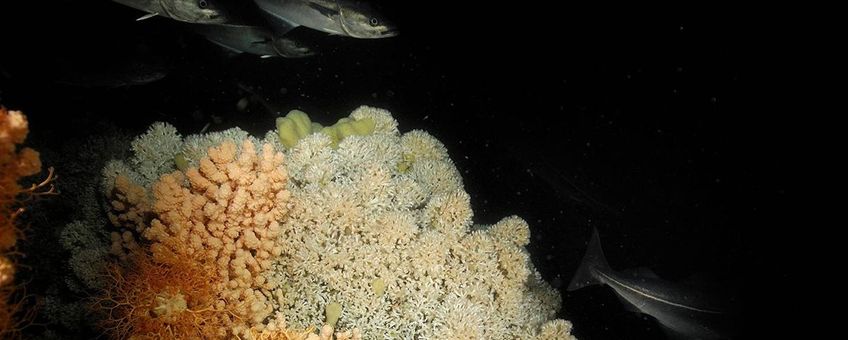
Deep sea research shows self-organising tiger patters in cold water coral reefs
NIOZ Royal Netherlands Institute for Sea ResearchAs light does not penetrate very deep into the ocean, it isn’t possible to make overview photos of the sea floor. PhD researcher Anna van der Kaaden, theoretical ecologist at Royal Netherlands Institute for Sea Research (NIOZ), has analysed large amounts of short-range video material from the deep sea to get a first glimpse of these patterns. Her findings are now published in Ecosphere.
Tiger Stripes
The cold-water reef patterns which are found, are nicknamed ‘tiger reef-patterns’ and are similar to the better-known ‘tiger bush’: parallel bands of vegetation on the African plains. They resemble sand ripples on the beach or the stripes of a zebra but are, in reality, areas with and without corals.
Ecosystems on land and in water have evolved ‘tricks’ by which they can react to environmental changes without losing their function. This makes ecosystems resilient. The formation of regular patterns is such a mechanism by which ecosystems can adjust gradually to changes. Sudden changes are typically unfavourable in ecosystems as they can often lead to the disappearance of certain ecosystem functions or to the extinction of species. These mechanisms have been described for many terrestrial and coastal ecosystems.

Proof of concept
“There were indications that cold-water corals also form regular spatial patterns through self-organisation, but this was never shown because of the difficulties of working in the deep sea. Light doesn’t penetrate well through water, so we can’t get aerial images of the deep seafloor. The images that we do have are from very close by,” says Van der Kaaden. Detailed data collected by deep sea research expedition consists mainly of ribbons of images that are each only two meters wide. How can you create an overview of a reef complex that is 15 kilometres long with only a few ribbons of images? Van der Kaaden and her colleagues had to do a lot of statistical analyses and create computer models of the reef. “We wanted to prove the concept that we can study self-organized spatial patterns by analysing this kind of imagery. This could be interesting for other deep sea ecosystems as well.”
Slow adjustment to environmental changes
Interestingly, regular patterns in cold-water coral occurrence were found. These patterns tell a lot about how these deep-sea reefs form and how they change when the climate changes. Cold-water corals are thought to be very sensitive to changes. They grow and develop very slowly. But this new study shows that the corals might be able to adjust their reef configuration to environmental changes.

A basis for restoration
Furthermore, the patterns occur not only in living corals but also in dead corals. This means that the dead coral framework provides template patterns that facilitate live coral recovery. “This finding is important for deep sea coral reef restoration,” says Van der Kaaden. “Plus, it tells us that bottom trawling is very harmful for the cold-water coral reefs, as they destroy these template patterns for coral recovery.”
Challenging study
It is impossible to make large-scale photos or scans of deep-sea ecosystems like cold-water coral reefs. Due to the darkness in the deep sea, the only available photo and video material is made within a few meters distance of the sea floor. Studying patterns in the available video material was a challenge for Van der Kaaden. She had to look at the deep-sea ecosystem like watching trough a narrow tube. You could compare it to studying a dune landscape with only information you can see directly besides the path you are walking on – nothing more. Van der Kaaden used mathematical tools to get information on recurring patterns in the ribbon of images from the sea floor. “I was very happy that the method worked; that we found regular patterns that suggest self-organization. It was a surprise that we could study the regular patterns both in the living and dead coral. By comparing them we got a lot of extra information.”
More information
- The article Tiger reefs: Self‐organized regular patterns in deep‐sea cold‐water coral reefs is published in Ecosphere.
Text: NIOZ
Photos: Dick van Oevelen, NIOZ; Norbert Dankers
